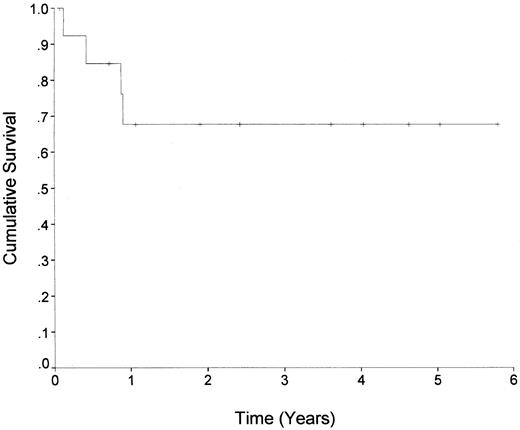To the Editor:
In a detailed analysis of 80 patients with multiple myeloma (MM) undergoing allogeneic bone marrow tranplantation Bensinger et al1 concluded that future studies of this treatment modality in MM should focus on the use of less toxic conditioning regimens applied earlier in the course of the disease. We would support these conclusions based on our own analysis of a smaller group of 13 patients undergoing allogeneic transplantation in Nottingham since 1990. Patient characteristics are shown in Table 1. As can be seen, the majority of patients were tranplanted early in their disease, 6 patients in first response and 7 in second response. The median time to tranplantation was 19 months and of the 6 patients transplanted in first response, all were transplanted within 18 months of diagnosis. The first patient received conditioning with fractionated total body irradiation (TBI) (12 Gy in 6 fractions) and cyclophosphamide (120 mg/kg), with all subsequent patients receiving fractionated TBI and melphalan (110 mg/m2). In addition, in the week before admission, patients received additional top up radiotherapy to sites of major bone disease if evident on skeletal survey. All patients received cyclosporin and a short course of methotrexate (15 mg/m2 on day +1 and 10 mg/m2 on day +3, +6, and +11) for prevention of graft-versus-host disease (GVHD). Twelve patients were transplanted from HLA-identical sibling donors; however, 1 patient in second response was transplanted from a 1 HLA-B mismatched sister. Twelve patients received bone marrow (BM) and 1 patient was transplanted with granulocyte colony-stimulating factor mobilized peripheral blood stem cells. Of the 13 patients transplanted 11 were evaluable posttranplant of whom 10 achieved a complete remission (CR) defined as a normal BM aspirate and trephine biopsy with a complete absence of monoclonal protein in blood or urine by immunofixation. No patient has relapsed and currently 9 are surviving, disease-free, ranging from 7 to 70 months posttransplant. Of the 6 patients tranplanted in first response, all within 18 months of diagnosis, 5 are in CR. The overall disease-free survival for all patients transplanted is shown in Fig 1. Four patients have died, 3 from transplant related causes. Of these, 2 patients died before day 100, 1 from acute GVHD (grade IV), and 1 from multiorgan failure; both patients were transplanted in second response. No other patient developed more than grade I acute GVHD. One further patient died in CR from influenza A pneumonitis at 5 months posttransplant and 1 patient, who failed to achieve a CR posttransplant, eventually died from progressive disease. This patient was transplanted 32 months from diagnosis and had received 2 previous chemotherapy regimens. She was also the only patient to receive cyclophosphamide and TBI conditioning therapy.
Patient Characteristics (n = 13)
| Median age (range) at transplantation | 49 yr (44-47) |
| Sex (M:F) | 6:7 |
| Stage at diagnosis | |
| I | 1 |
| II | 3* |
| III | 9† |
| No. of previous lines of treatment | |
| 1 | 6 |
| 2 | 7 |
| Median time (range) from diagnosis to transplant | 19 mo (5-53) |
| Median age (range) at transplantation | 49 yr (44-47) |
| Sex (M:F) | 6:7 |
| Stage at diagnosis | |
| I | 1 |
| II | 3* |
| III | 9† |
| No. of previous lines of treatment | |
| 1 | 6 |
| 2 | 7 |
| Median time (range) from diagnosis to transplant | 19 mo (5-53) |
One patient had systemic amyloidosis complicating myeloma.
One patient had plasma cell leukemia with a peripheral blood plasma cell count of 72 × 109/L at presentation.
From these results we would suggest that fractionated TBI and melphalan is a well tolerated conditioning regimen for patients with MM. The dose of melphalan used in our series (110 mg/m2) is lower than is conventionally used with TBI in autologous PBSCT for MM (140 mg/m2).2 This lower dose melphalan was chosen in an attempt to reduce regimen related toxicity and to minimize mortality in a predominantly older group of patients with a disease characterized by a high transplant related mortality (TRM).3 The high rate of CR (10 out of 11 patients) and relatively low probability of day 100 nonrelapse mortality (15%) compared to other studies1,3 would suggest that this is an effective and relatively nontoxic antimyeloma conditioning regimen. The group of patients reported here were generally transplanted earlier in their disease than the patients reported by Bensinger et al1 and no patient had received more than 2 lines of conventional therapy before proceeding to transplant. Thus the high response rate, low relapse rate, and low TRM may also reflect this. The EBMT experience has also shown that patients transplanted following just 1 line of chemotherapy have a superior CR rate and overall survival compared with patients transplanted with more advanced disease.4 Finally, the results reported here and elsewhere,1 3 which suggest that some patients with MM undergoing allogeneic bone marrow transplant may be cured of their disease, means that we continue to evaluate allogeneic transplantation in preference to autologous PBSCT for all newly diagnosed MM patients <50 years with poor prognostic features who have a fully matched sibling donor.


This feature is available to Subscribers Only
Sign In or Create an Account Close Modal